Figure 1.
Simplified version of the two-gonadotropin, two-cell model of the normal regulation of ovarian steroidogenesis during the early to midfollicular phase of the menstrual cycle. This diagram shows the major relationships evaluated in this study. LH (or the LH analog hCG) stimulates theca cells to form androgen. Androgens are used as substrates for estrogen formation by granulosa cells, a process requiring aromatase activity, which is normally up-regulated by FSH in accord with the state of maturation of granulosa cells. Gonadotrope secretion of FSH is more sensitive than LH to endocrine negative-feedback regulation by the granulosa cell products estradiol and inhibin (fine dotted line). FSH-dependent granulosa cell factors, including estradiol and inhibin-B, also act in an intraovarian paracrine manner to modulate the androgenic response to LH/hCG positively (+) or negatively (−) in accord with granulosa cell needs (heavy dotted lines). A’dione, Androstenedione; T, testosterone. Based on model of Ehrmann et al. (8).

